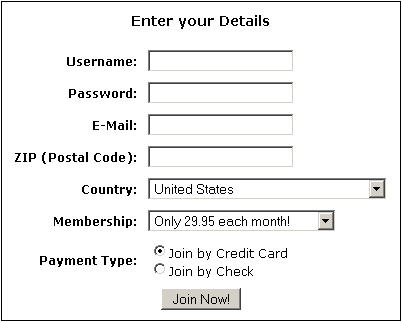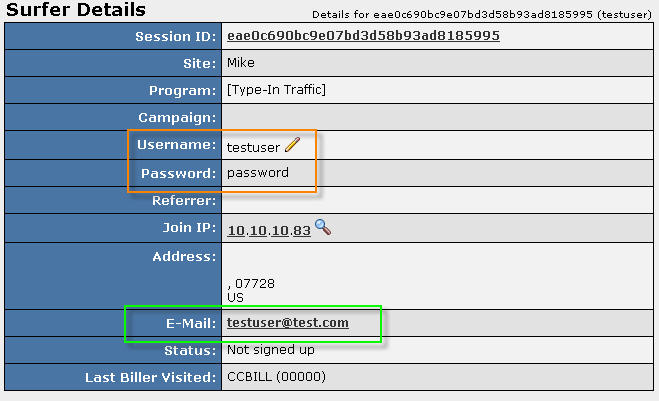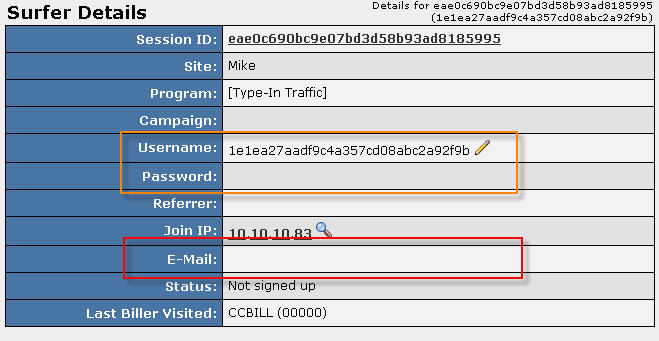Difference between revisions of "Autocascade"
m |
TMMStephenY2 (talk | contribs) |
||
| Line 6: | Line 6: | ||
}} | }} | ||
| − | + | When you set a [[ct#Cascade|cascade's]] weight field to 256 in [[NATS]], you enable the | |
| − | "autocascade" feature. | + | "autocascade" feature which causes [[ct#Surfer|surfers]] to bypass the [[NATS]] pre-join form and go straight to a biller join form. This also bypasses the authentication procedure in the NATS pre-join form. |
== Normal Join Form and Cascading Behavior == | == Normal Join Form and Cascading Behavior == | ||
| − | Normally | + | Normally when a surfer visits the [[ct#Join Form|join form]] link, the NATS pre-join |
| − | form | + | form will be displayed-- this form captures surfer information and checks to |
| − | see if the username and email the surfer | + | see if the username and email the surfer entered has already been taken. |
Once submitted, the NATS pre-join form validates the data entered | Once submitted, the NATS pre-join form validates the data entered | ||
| − | and | + | and sends the surfer to the first [[ct#Biller|biller]] in the cascade's join form. Figures 1.1 and 1.2 provide examples of the default NATS join form flow: |
| − | provide examples of the default NATS join form flow: | ||
[[Image:Autocascade_normal_flow.jpg|frame|center|||Figure 1.1 - Normal NATS Join Form Flow]] | [[Image:Autocascade_normal_flow.jpg|frame|center|||Figure 1.1 - Normal NATS Join Form Flow]] | ||
| Line 22: | Line 21: | ||
If Autocascading is enabled by setting the Weight value to 256, then | If Autocascading is enabled by setting the Weight value to 256, then | ||
| − | NATS | + | NATS will bypass the NATS pre-join form and automatically send the [[ct#Surfer|surfer]] |
to the biller's join form. Normally, if a surfer hit's a NATS pre-join form, | to the biller's join form. Normally, if a surfer hit's a NATS pre-join form, | ||
completes the form and never fully signs up, you'll see a | completes the form and never fully signs up, you'll see a | ||
| Line 32: | Line 31: | ||
[[Image:Autocascade_auto_member.jpg|frame|center||||Figure 1.4 - Default Join Form Content]] | [[Image:Autocascade_auto_member.jpg|frame|center||||Figure 1.4 - Default Join Form Content]] | ||
| − | You may have noticed that the member from Figure 1.3 actually contains a | + | You may have noticed that the member record from Figure 1.3 actually contains a |
username, password, and email address. This allows you to reference this | username, password, and email address. This allows you to reference this | ||
| − | + | member's record in the future, or use the information for a subsequent never-joined | |
| − | advertisement [[ct#Campaign|campaign]]. The member in Figure 1.4 contains no surfer | + | advertisement [[ct#Campaign|campaign]]. The member created through an Autocascade in Figure 1.4 contains no surfer submitted data and is essentially a useless record as it contains no important member information. |
| − | submitted data and is essentially a useless record. | ||
== Benefits and Drawbacks of Autocascading == | == Benefits and Drawbacks of Autocascading == | ||
| − | |||
| − | |||
| − | |||
| − | In contrast, the regular cascading method and pre-join form is usually | + | Many surfers prefer autocascades, as it generally reduces the amount of information necessary to sign up. When a potential member only has a single join form to complete, instead of multiple, they will generally be more receptive to completing the transaction. |
| − | more practical | + | |
| − | have a pre-join record of that surfer that can be used for | + | In contrast, many clients and affiliates prefer the regular cascading method and pre-join form, as it is usually more practical. The regular method allows you to retain future marketing information and also have a pre-join record of that surfer that can be used for future troubleshooting. |
| − | troubleshooting. | ||
[[Category:Also NATS4 Article]] | [[Category:Also NATS4 Article]] | ||
Revision as of 12:03, 4 June 2010
NATS 3
|
|---|
When you set a cascade's weight field to 256 in NATS, you enable the "autocascade" feature which causes surfers to bypass the NATS pre-join form and go straight to a biller join form. This also bypasses the authentication procedure in the NATS pre-join form.
Normal Join Form and Cascading Behavior
Normally when a surfer visits the join form link, the NATS pre-join form will be displayed-- this form captures surfer information and checks to see if the username and email the surfer entered has already been taken. Once submitted, the NATS pre-join form validates the data entered and sends the surfer to the first biller in the cascade's join form. Figures 1.1 and 1.2 provide examples of the default NATS join form flow:
If Autocascading is enabled by setting the Weight value to 256, then NATS will bypass the NATS pre-join form and automatically send the surfer to the biller's join form. Normally, if a surfer hit's a NATS pre-join form, completes the form and never fully signs up, you'll see a record similar to that of Figure 1.3. If you use autocascading, you'll see accounts that look more like that in Figure 1.4:
You may have noticed that the member record from Figure 1.3 actually contains a username, password, and email address. This allows you to reference this member's record in the future, or use the information for a subsequent never-joined advertisement campaign. The member created through an Autocascade in Figure 1.4 contains no surfer submitted data and is essentially a useless record as it contains no important member information.
Benefits and Drawbacks of Autocascading
Many surfers prefer autocascades, as it generally reduces the amount of information necessary to sign up. When a potential member only has a single join form to complete, instead of multiple, they will generally be more receptive to completing the transaction.
In contrast, many clients and affiliates prefer the regular cascading method and pre-join form, as it is usually more practical. The regular method allows you to retain future marketing information and also have a pre-join record of that surfer that can be used for future troubleshooting.



